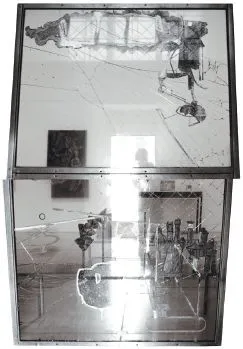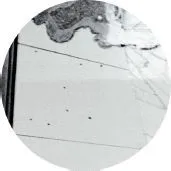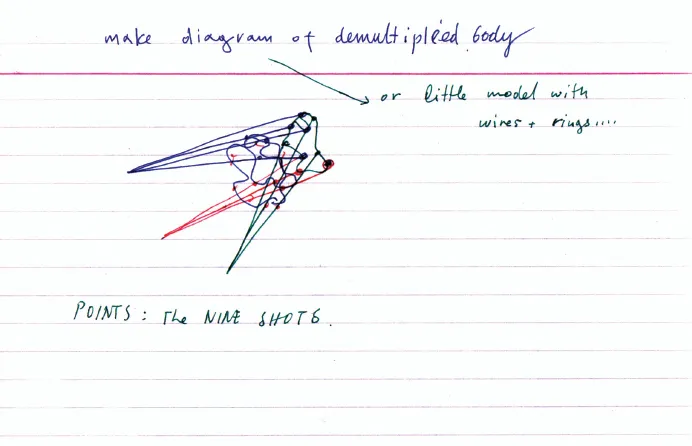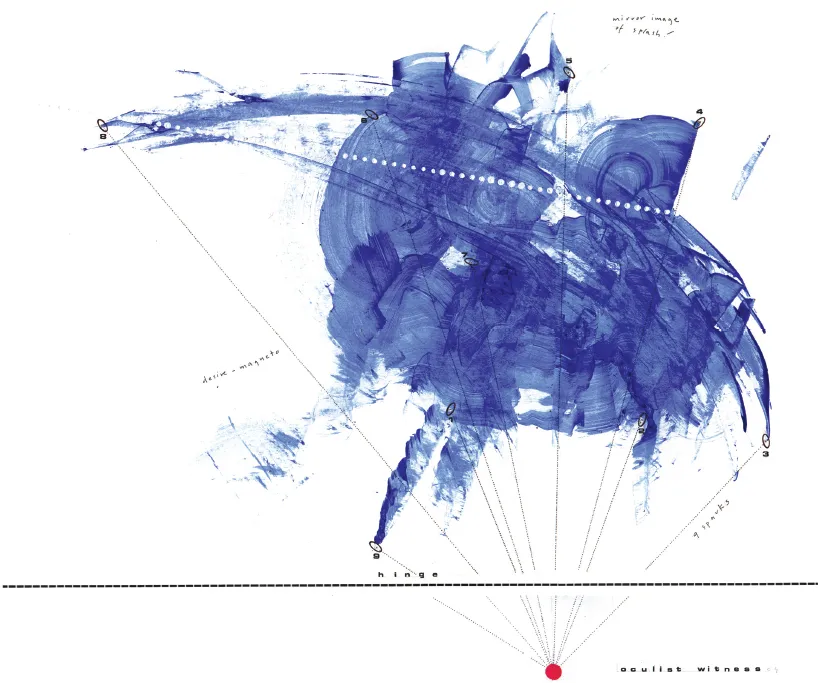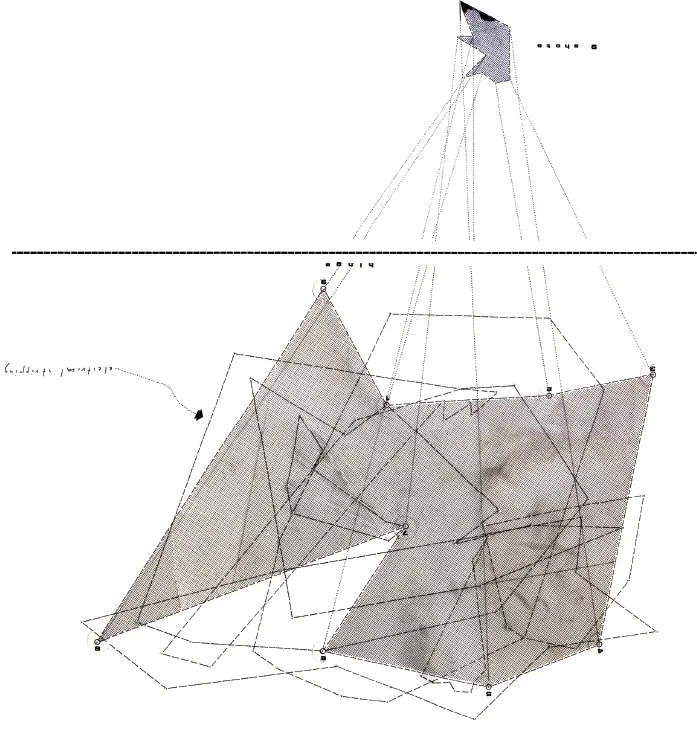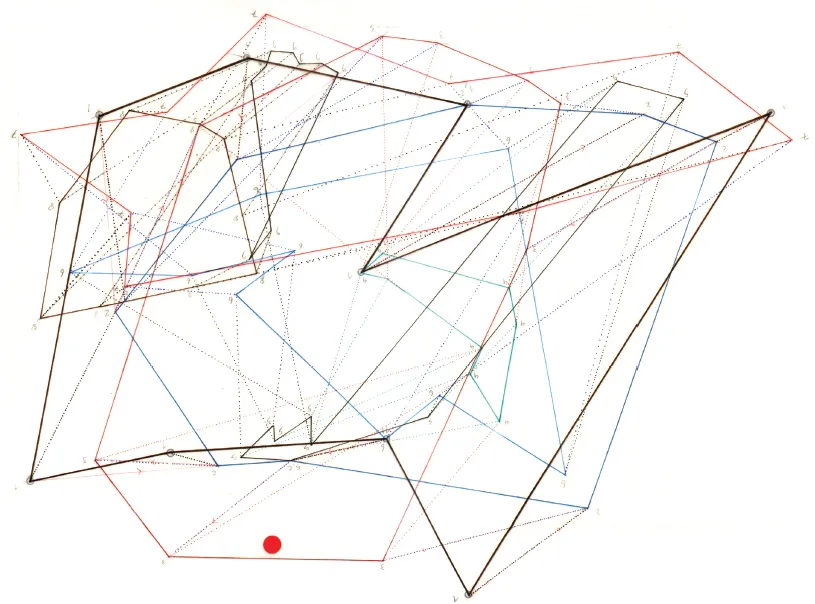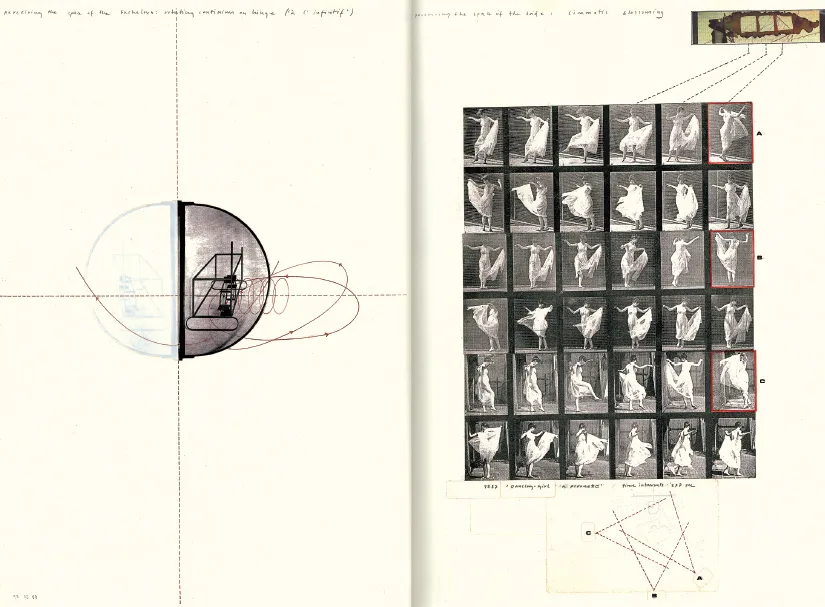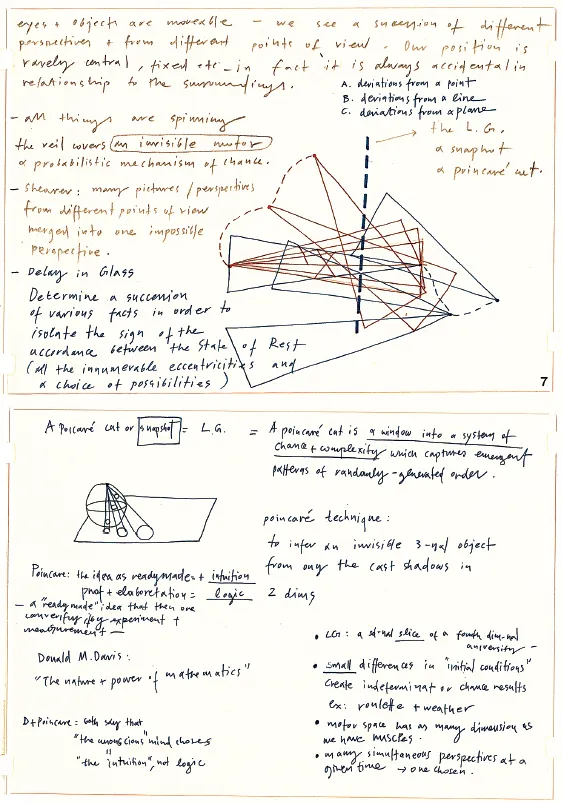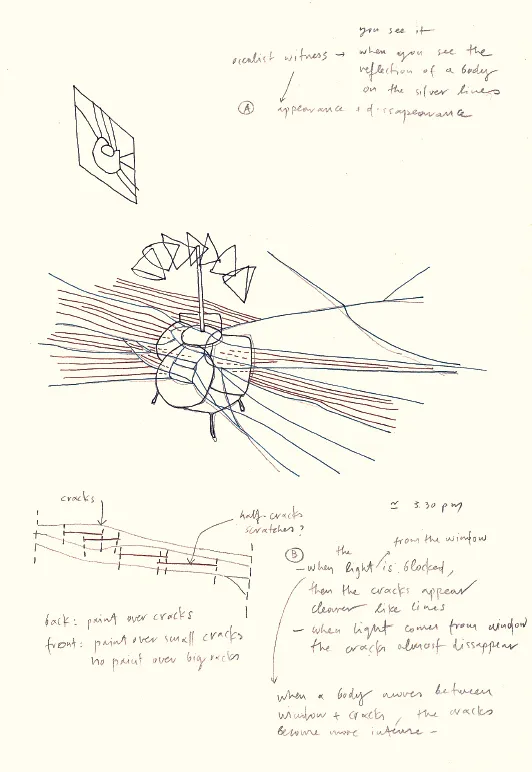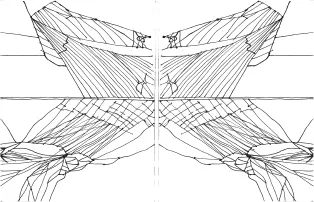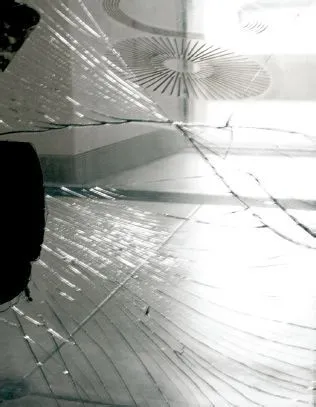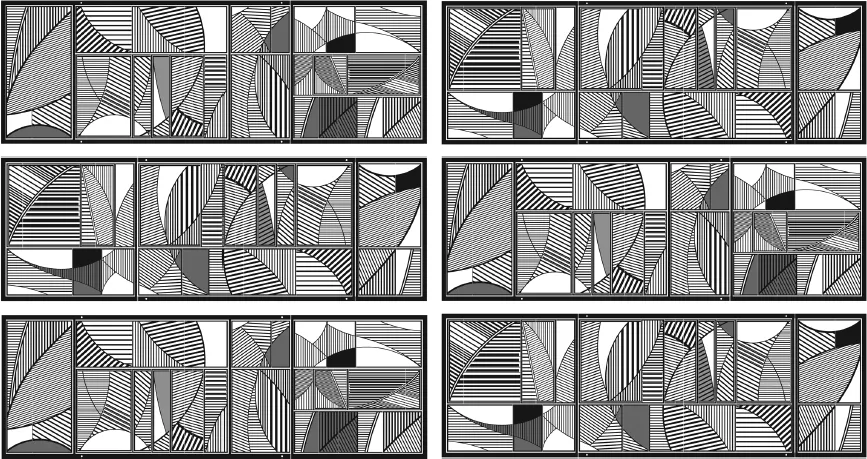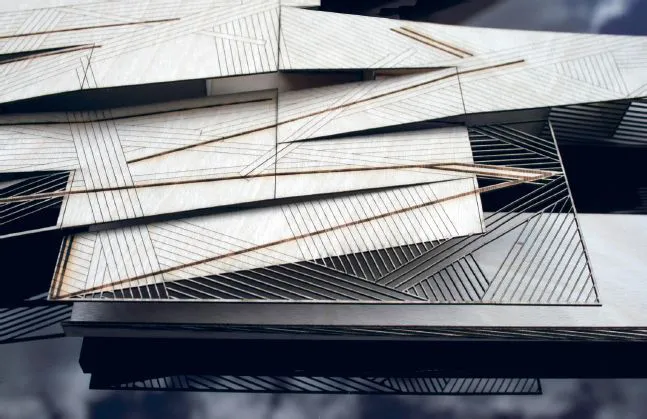![]()
Chance in Design
The confusion is not my invention. … It is all around us and our only chance now is to let it in. The only chance of renovation is to open our eyes and see the mess. … What I am saying does not mean that there will henceforth be no form in art. It only means that there will be new form, and that his form will be of such type that it admits the chaos and does not try to say that the chaos is really something else. The form and the chaos remain separate. The latter is not reduced to the former. … To find a form that accommodates the mess, that is the task of the artist now.
Samuel Beckett, Interview with Tom Driver, 196l
![]()
PROJECTIONS1 After Duchamp
C01
C01 The Bride Stripped Bare by her Bachelors, Even (1915–23), also called the Large Glass, permanently installed in the Philadelphia Museum and photographed in two shots from the back, 1999.
C02 C03 Duchamp stood at three different locations and from each one he shot the upper part of the work three times with a toy cannon. And so, with the aid of chance, he depicted the most minimal element of visual representation, the point, associating it also with the vanishing point of linear perspective. The diagram is for the making of an adjustable three-dimensional object with colour-coded elastic wires and rings. This object would represent Duchamp’s nine hypothetical bullet trajectories and would stand metaphorically for vision as being spatial, fluid and in motion.
C04 When the gas touches the Bride as an amorphous splash, an ‘electrical stripping’ occurs. The Bachelors’ domain is drawn in a rectilinear manner based on Euclidean rules. The volume of gas in the Bride’s domain is drawn in a haptic way, guided by the punctured holes.
C05 Drawing of the possibility of contact between the Bachelors and the Bride. This momentary contact is imagined through the ‘demultiplied’ body of vision, a trajectory of vision which is spatial, multiple and in constant motion, as it originates from the eye, the Oculist Witnesses on the Bachelors’ panel (red dot), and projects itself onto the Bride’s panel (blue cloud). Measurable and geometrical organization for the Bachelors panel; impulsive and indeterminable configuration for the Bride’s panel.
C06 Nine points (one point for each Bachelor), each one multiplied nine times. Each network of nine points is outlined with a different color. The dotted lines indicate the combined trajectory of the Bachelors while they traverse through different configurations in search for their final position close to the Bride.
C07 The trajectory of the demultiplied body of vision happens through rotation as the Bachelors’ domain hinges to meet the Bride’s territory. The gaze of the nine Bachelors explodes to perforate the plane of the Bride. All eighty-one (nine by nine) points pierce the paper as holes to allow the ‘illuminating gas’ to reach the Bride on the back side of the drawing.
C02
C03
C04
C05
C06
C07
C08
C08 The Milky Way represents the Bride’s experience of ‘cinematic blossoming’ and is formed by the three air-blown nets of the Draft Pistons. For the Milky Way Duchamp originally used the French title Voil lacteé which, as Craig Adcock suggests, sounds like voile acté, meaning ‘enacted veil’. Eadweard Muybridge’s photographic work Dancing Girl—A Pirouette (1887) depicts a ‘bride’ pirouetting with a veil. Muybridge set up his cameras ‘watching’ from three different viewpoints while the observed woman-in-action would trip a sequence of wires, automatically releasing the shutters. In this manner three simultaneous but different views were captured on different plates. While Muybridge’s isolated snapshots encouraged the viewer to imagine the missing fragments of the full action, the physiologist Étienne-Jules Marey, who was inspired by Muybridge, created chronophotographs to offer the viewer the entire movement from start to finish in one image. It is easy to see Marey’s influence on Duchamp’s figure of the Nude Descending a Staircase and Muybridge’s influence on the triptych of the Milky Way for the Large Glass.
C09
C010
C011
C09 Duchamp’s and Poincaré’s understandings of space had a triple form: visual, tactile and motor. But Duchamp’s interest in representation expands beyond Poincaré’s rationale to include questions of desire, emotion and play. Duchamp challenged, if not ridiculed, the dominance of scientific truth, pointing to its arbitrariness and limitations. His interrogations were more about the subjectivity of the individual and one’s own fabrications of chance rather than any notion of universal chance.
C010 C011 These drafts for an animation represent the mismatch between the painting of the Large Glass as is and the painting as drawn from observation.
C012
C013
C012 C013 The aim of the animation would be to draw parallels between Duchamp’s definition of the ‘art coefficient’ as ‘the difference between intention and realisation’ and Lacan’s discussion about the structuring of the image as a screen that masks the real.
C014 C015 Study of the breakage of the Large Glass sketched from observation in the Philadelphia Museum of Art in 1999. Isolating the cracks from the figurative content of the work reveals the structural logic of the forces of the accident. Duchamp saw the cracks as a real ‘canned’ chance and a necessary addition to the piece.
C016 Due to its breakage and decay the Large Glass has become more remarkable over time. Positioned in front of a window in the Philadelphia Museum of Art, its impact on the viewer is incomparable to those of its intact replicas. Light exposes the disintegrating areas of the painting, giving it an extra plastic quality. It illuminates the cracks and makes the work sparkle.
C014
C015
C016
Notes
1 Refer to Chapter 6 which is entirely devoted to Marcel Duchamp’s experimental use of chance.
![]()
SHUTTERS House F
D01
There is a branch of architectural research that is particularly worth considering. It involves drawing and making that is not at first sight directly applicable, in the sense of logically solving building problems. This type of drawing and making would not routinely result in generally ‘useful’ products. Instead it constructs helpful mediating devices for the architect-researcher, standing somewhere between imagination and application, and helping her invent her own questions. These devices derive from the desire to play freely with an idea, without having to find deterministic solutions to situations. They help the designer, even if only temporarily, to enter the children’s zone of ‘unformed’ toys: an enjoyable and independent world of interrogating ideas through indeterminate play.1
D01 Shutters explores relationality within the context of House F—a building design for a single-family house in Patras, Greece.2 The piece attempts to capture the visual essence of an array of hinged panels that could intertwine the edge of the house. The panels would create a fugitive zone between the interior and the surrounding olive grove, a place sensitive to the changeable conditions of light, weather and inhabitation.
D02 Imagine openings, hinges, folds and breakages for an arrangement of flexible shutters. Lines, surfaces and shadows as ethereal as a three-dimensional drawing, perhaps resembling the infra-thin line structure of leaf veins. Make a flat template with adjustable parts that can be repeated to make a larger and more complex model with reconfigurable surfaces.
D03 Paint the planes of the model pale green on the front, silver on the back, recalling the flickering of olive leaves in the Mediterranean sun. Turn the hinged planes, some inward and some outward, splitting each one of the shutters into two or more parts. To fold or not; to position here or there; to show silver or green. What shadows will be cast?
D04 In addition the project describes a design mode that is useful beyond the limits of the particular house. As a reconfigurable model, always present in the studio, it can influence the making of other works.
D05 For example, it led to our design for the Visitor’s Centre for the Brockholes Wetland and Woodland Nature Reserve in NW England.3
D02
D03
D04
Just as natural materials such as sand, water, bark and rock are ideal unformed toys for a child’s imaginative play, Shutters is an unformed architectural object, an open-ended toy for design. Each time a part of Shutters is unfolded, a new motif appears. Reconfiguring the plasticity of this piece resembles playing chess or rearranging the words of a poem.
But is our strong desire to play with chance—as children, designers or creative adults in general—acquired empirically or inborn? Developmental psychologists Jean Piaget and Bärbel Inhelder investigated this question by asking whether the intuition of chance is as fundamental as, say, that of whole numbers (understanding 1, 2, 3 and so on). Through a number of experiments they demonstrated that in fact young children have no concept of chance at all.4 This is because they have neither a concept of law nor a concept of design as an organized operation. Children before the age of seven make decisions about future occurrences in an entirely emotional manner. In an experiment with a spinning bar Piaget and Inhelder asked ‘Do we know where the bar will stop? On the yellow’, the child answered. When asked why, the child replied, ‘because that’s a wonderful yellow’. When the ball eventually stopped on the blue ball the child would come up with a justification, such as ‘the bar got tired’!5 Children under seven years old fail to differentiate between the possible and the necessary. On the other hand seven-to eleven-year-olds discover the existence (and irreversibility) of chance but only through its antithesis: tangible organized operations that they can now perform. Finally, at eleven or twelve years of age children can deal with both tangible and hypothetical operations, construct a synthesis between chance and design, and gradually build their judgement of probability. Piaget and Inhelder’s experiments prove that chance and order as fundamentally interdependent ideas begin to take shape in one’s consciousness only after the age of seven.
The idea of chance is a ‘secondary and derived reality’ dependent on the search for order and its...

